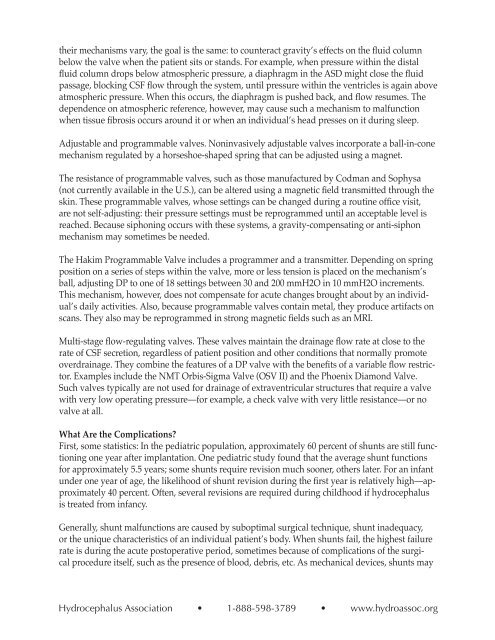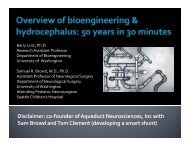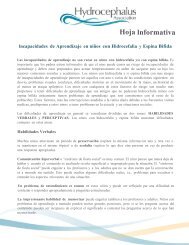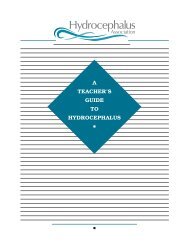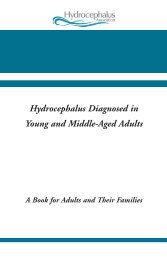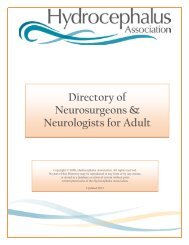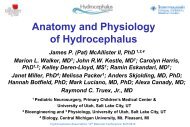Fact Sheet: Cerebrospinal Fluid Shunt Systems for the Management ...
Fact Sheet: Cerebrospinal Fluid Shunt Systems for the Management ...
Fact Sheet: Cerebrospinal Fluid Shunt Systems for the Management ...
Create successful ePaper yourself
Turn your PDF publications into a flip-book with our unique Google optimized e-Paper software.
<strong>the</strong>ir mechanisms vary, <strong>the</strong> goal is <strong>the</strong> same: to counteract gravity’s effects on <strong>the</strong> fluid column<br />
below <strong>the</strong> valve when <strong>the</strong> patient sits or stands. For example, when pressure within <strong>the</strong> distal<br />
fluid column drops below atmospheric pressure, a diaphragm in <strong>the</strong> ASD might close <strong>the</strong> fluid<br />
passage, blocking CSF flow through <strong>the</strong> system, until pressure within <strong>the</strong> ventricles is again above<br />
atmospheric pressure. When this occurs, <strong>the</strong> diaphragm is pushed back, and flow resumes. The<br />
dependence on atmospheric reference, however, may cause such a mechanism to malfunction<br />
when tissue fibrosis occurs around it or when an individual’s head presses on it during sleep.<br />
Adjustable and programmable valves. Noninvasively adjustable valves incorporate a ball-in-cone<br />
mechanism regulated by a horseshoe-shaped spring that can be adjusted using a magnet.<br />
The resistance of programmable valves, such as those manufactured by Codman and Sophysa<br />
(not currently available in <strong>the</strong> U.S.), can be altered using a magnetic field transmitted through <strong>the</strong><br />
skin. These programmable valves, whose settings can be changed during a routine office visit,<br />
are not self-adjusting: <strong>the</strong>ir pressure settings must be reprogrammed until an acceptable level is<br />
reached. Because siphoning occurs with <strong>the</strong>se systems, a gravity-compensating or anti-siphon<br />
mechanism may sometimes be needed.<br />
The Hakim Programmable Valve includes a programmer and a transmitter. Depending on spring<br />
position on a series of steps within <strong>the</strong> valve, more or less tension is placed on <strong>the</strong> mechanism’s<br />
ball, adjusting DP to one of 18 settings between 30 and 200 mmH2O in 10 mmH2O increments.<br />
This mechanism, however, does not compensate <strong>for</strong> acute changes brought about by an individual’s<br />
daily activities. Also, because programmable valves contain metal, <strong>the</strong>y produce artifacts on<br />
scans. They also may be reprogrammed in strong magnetic fields such as an MRI.<br />
Multi-stage flow-regulating valves. These valves maintain <strong>the</strong> drainage flow rate at close to <strong>the</strong><br />
rate of CSF secretion, regardless of patient position and o<strong>the</strong>r conditions that normally promote<br />
overdrainage. They combine <strong>the</strong> features of a DP valve with <strong>the</strong> benefits of a variable flow restrictor.<br />
Examples include <strong>the</strong> NMT Orbis-Sigma Valve (OSV II) and <strong>the</strong> Phoenix Diamond Valve.<br />
Such valves typically are not used <strong>for</strong> drainage of extraventricular structures that require a valve<br />
with very low operating pressure—<strong>for</strong> example, a check valve with very little resistance—or no<br />
valve at all.<br />
What Are <strong>the</strong> Complications?<br />
First, some statistics: In <strong>the</strong> pediatric population, approximately 60 percent of shunts are still functioning<br />
one year after implantation. One pediatric study found that <strong>the</strong> average shunt functions<br />
<strong>for</strong> approximately 5.5 years; some shunts require revision much sooner, o<strong>the</strong>rs later. For an infant<br />
under one year of age, <strong>the</strong> likelihood of shunt revision during <strong>the</strong> first year is relatively high—approximately<br />
40 percent. Often, several revisions are required during childhood if hydrocephalus<br />
is treated from infancy.<br />
Generally, shunt malfunctions are caused by suboptimal surgical technique, shunt inadequacy,<br />
or <strong>the</strong> unique characteristics of an individual patient’s body. When shunts fail, <strong>the</strong> highest failure<br />
rate is during <strong>the</strong> acute postoperative period, sometimes because of complications of <strong>the</strong> surgical<br />
procedure itself, such as <strong>the</strong> presence of blood, debris, etc. As mechanical devices, shunts may<br />
Hydrocephalus Association • 1-888-598-3789 • www.hydroassoc.org


